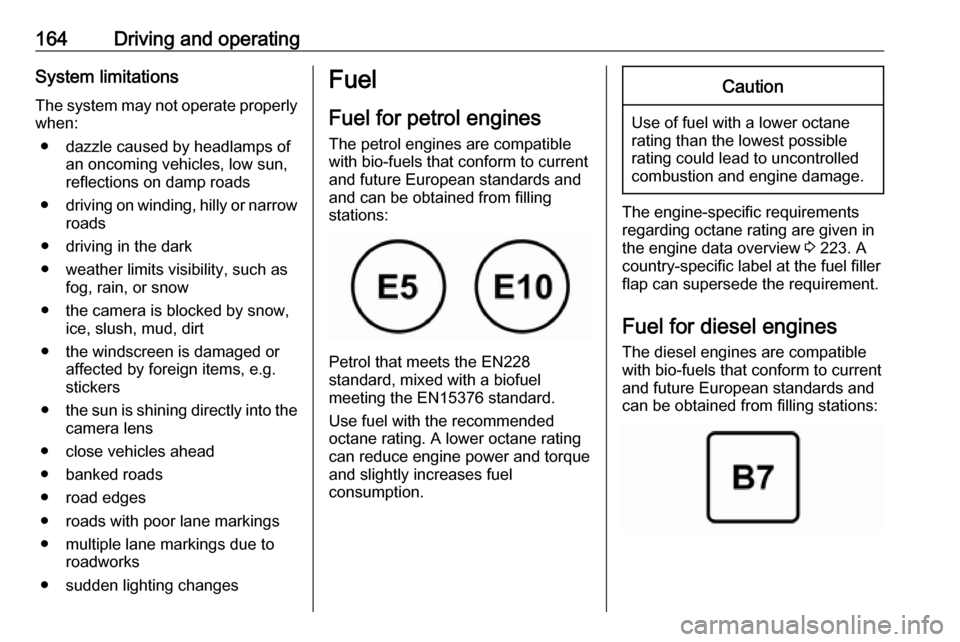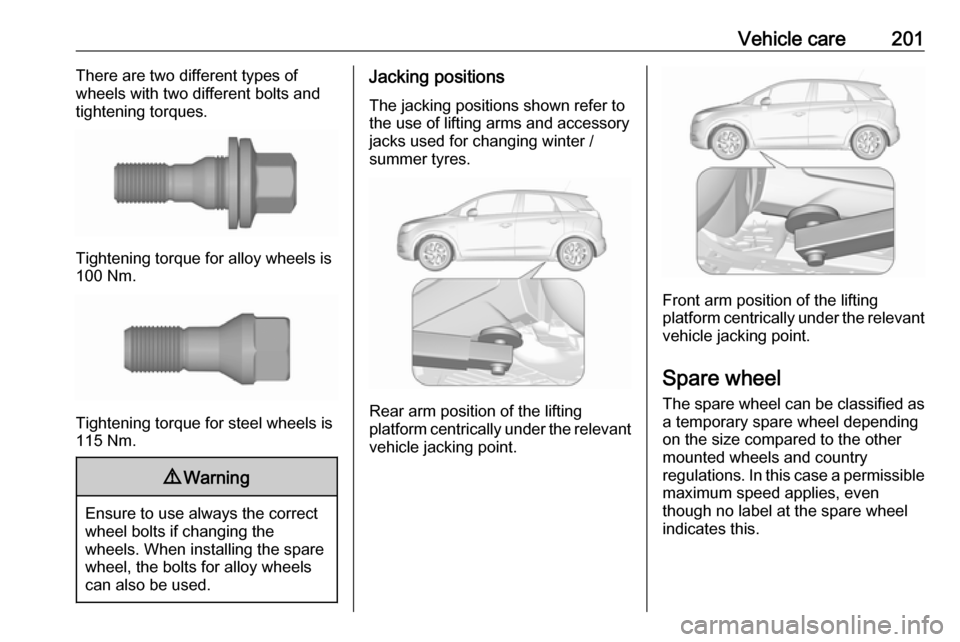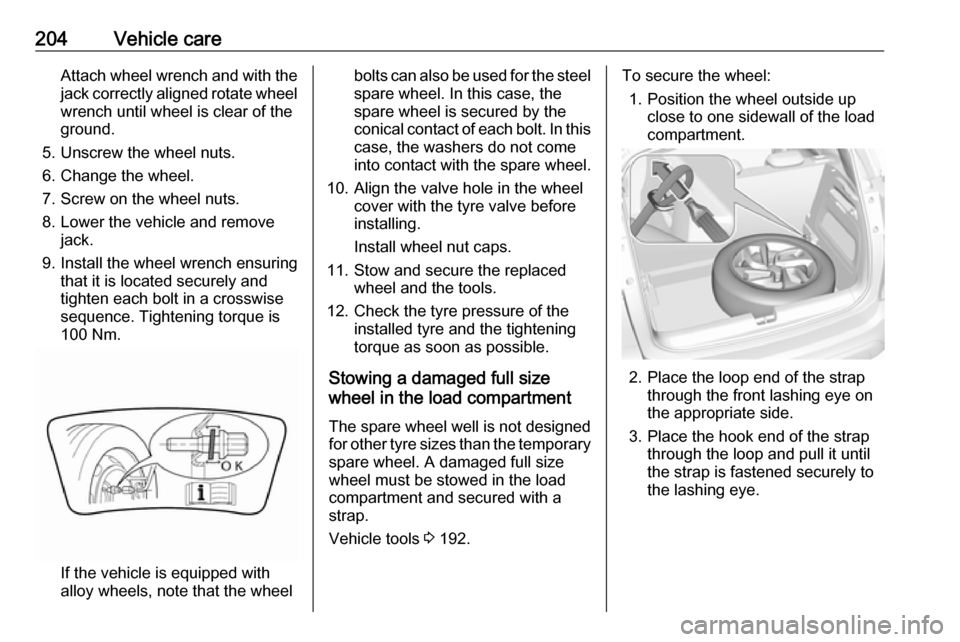2019.75 VAUXHALL CROSSLAND X torque
[x] Cancel search: torquePage 126 of 247

124Driving and operating●Do not operate accelerator pedal.
● Diesel engines: wait until control indicator ! extinguishes.
● Turn key to position 2 and
release after the engine has been started.
Manual transmission: during an
Autostop, the engine can be started
by depressing the clutch pedal
3 125.
Automatic transmission: during an
Autostop, the engine can be started
by releasing the brake pedal 3 125.
Vehicles with power button● Manual transmission: operate clutch and brake pedal.
● Automatic transmission: operate brake pedal and move selector
lever to P or N.
● Do not operate accelerator pedal.
● Press Start/Stop button. Release
button after starting procedure
begins.
● Diesel engine starts after control indicator ! for preheating
extinguishes.
● Before restarting or to switch off the engine when vehicle is
stationary, press Start/Stop once
more briefly.
To start the engine during an
Autostop:
● Manual transmission: during an Autostop, the engine can be
started by depressing the clutch
pedal 3 125.
● Automatic transmission: during an Autostop, the engine can be
started by releasing the brake
pedal 3 125.Starting the vehicle at low
temperatures
Starting the engine without additional
heaters is possible down to -25 °С for diesel engines and -30 °C for petrol
engines.
Required is an engine oil with the
correct viscosity, the correct fuel,
performed services and a sufficiently
charged vehicle battery.
With temperatures below -30 °C the
automatic transmission requires a
warming phase of approx. 5 minutes.
The selector lever must be in position
P .
Turbo engine warm-up
Upon start-up, engine available
torque may be limited for a short time, especially when the engine
temperature is cold. The limitation is
to allow the lubrication system to fully
protect the engine.
Page 166 of 247

164Driving and operatingSystem limitations
The system may not operate properly
when:
● dazzle caused by headlamps of an oncoming vehicles, low sun,
reflections on damp roads
● driving on winding, hilly or narrow
roads
● driving in the dark
● weather limits visibility, such as fog, rain, or snow
● the camera is blocked by snow, ice, slush, mud, dirt
● the windscreen is damaged or affected by foreign items, e.g.
stickers
● the sun is shining directly into the
camera lens
● close vehicles ahead ● banked roads
● road edges
● roads with poor lane markings
● multiple lane markings due to roadworks
● sudden lighting changesFuel
Fuel for petrol engines The petrol engines are compatible
with bio-fuels that conform to current
and future European standards and
and can be obtained from filling
stations:
Petrol that meets the EN228
standard, mixed with a biofuel
meeting the EN15376 standard.
Use fuel with the recommended
octane rating. A lower octane rating
can reduce engine power and torque
and slightly increases fuel
consumption.
Caution
Use of fuel with a lower octane
rating than the lowest possible
rating could lead to uncontrolled combustion and engine damage.
The engine-specific requirements
regarding octane rating are given in
the engine data overview 3 223. A
country-specific label at the fuel filler
flap can supersede the requirement.
Fuel for diesel engines The diesel engines are compatiblewith bio-fuels that conform to currentand future European standards and
can be obtained from filling stations:
Page 202 of 247

200Vehicle carebefore. Drain excess tyrepressure with the button on the air
hose.
If tyre pressure hasn't decreased under 1.5 bar, set it to the correct
value. Otherwise the vehicle must
not be used. Seek assistance of a workshop.
Repeat the checking procedure
once more after driving further
6 miles (but no more than
10 minutes) to check that there is
no more loss of pressure.
If the tyre pressure has fallen
below 1.5 bar, the vehicle must
not be used. Seek the assistance
of a workshop.
17. Stow away tyre repair kit in load compartment.
Notice
The driving characteristics of the
repaired tyre are severely affected,
therefore have this tyre replaced.
If unusual noise is heard or the
compressor becomes hot, turn
compressor off for at least
30 minutes.The built-in safety valve opens at a
pressure of 7 bar (102 psi).
Note the expiry date of the kit. After
this date its sealing capability is no
longer guaranteed. Pay attention to
storage information on sealant
bottle.
Replace the used sealant bottle. Dispose of the bottle as prescribed
by applicable laws.
The compressor and sealant can be used from approx. -30 °C.
Wheel changing
Make the following preparations and
observe the following information:
● Park the vehicle on a level, firm and non-skid surface. The front
wheels must be in the straight-
ahead position.
● If necessary, place a chock under
the wheel diagonally opposite the wheel to be changed.
● Apply the parking brake and engage first gear, reverse gear or
P .● If the ground on which the vehicle
is standing is soft, a solid board
(max. 1 cm thick) should be
placed under the jack.
● Take heavy objects out of the vehicle before jacking up.
● No people or animals may be in the vehicle when it is jacked-up.
● Never crawl under a jacked-up vehicle.
● Do not start the vehicle when it is
raised on the jack.
● Before screwing in the wheel bolts, clean them.9Warning
Do not grease wheel bolts.
Tightening torques
Caution
If the vehicle is equipped with alloy
wheels, tighten the wheel bolts
manually at least for the first five
turns.
Page 203 of 247

Vehicle care201There are two different types of
wheels with two different bolts and
tightening torques.
Tightening torque for alloy wheels is
100 Nm.
Tightening torque for steel wheels is
115 Nm.
9 Warning
Ensure to use always the correct
wheel bolts if changing the
wheels. When installing the spare
wheel, the bolts for alloy wheels can also be used.
Jacking positions
The jacking positions shown refer to
the use of lifting arms and accessory
jacks used for changing winter /
summer tyres.
Rear arm position of the lifting
platform centrically under the relevant vehicle jacking point.
Front arm position of the lifting
platform centrically under the relevant vehicle jacking point.
Spare wheel The spare wheel can be classified as
a temporary spare wheel depending
on the size compared to the other
mounted wheels and country
regulations. In this case a permissible maximum speed applies, even
though no label at the spare wheel
indicates this.
Page 206 of 247

204Vehicle careAttach wheel wrench and with the
jack correctly aligned rotate wheel wrench until wheel is clear of the
ground.
5. Unscrew the wheel nuts. 6. Change the wheel.
7. Screw on the wheel nuts.
8. Lower the vehicle and remove jack.
9. Install the wheel wrench ensuring that it is located securely and
tighten each bolt in a crosswise
sequence. Tightening torque is
100 Nm.
If the vehicle is equipped with
alloy wheels, note that the wheel
bolts can also be used for the steel spare wheel. In this case, the
spare wheel is secured by the
conical contact of each bolt. In this
case, the washers do not come
into contact with the spare wheel.
10. Align the valve hole in the wheel cover with the tyre valve before
installing.
Install wheel nut caps.
11. Stow and secure the replaced wheel and the tools.
12. Check the tyre pressure of the installed tyre and the tightening
torque as soon as possible.
Stowing a damaged full size
wheel in the load compartment
The spare wheel well is not designed for other tyre sizes than the temporary
spare wheel. A damaged full size
wheel must be stowed in the load
compartment and secured with a
strap.
Vehicle tools 3 192.To secure the wheel:
1. Position the wheel outside up close to one sidewall of the load
compartment.
2. Place the loop end of the strap through the front lashing eye on
the appropriate side.
3. Place the hook end of the strap through the loop and pull it until
the strap is fastened securely to
the lashing eye.
Page 225 of 247
![VAUXHALL CROSSLAND X 2019.75 Owners Manual Technical data223Engine dataEngine identifier codeD12xE / F12xED12xHL / F12xHLD12xHT / F12xHTSales designation1.21.2 Turbo1.2 TurboEngineering codeEB2FAEB2DT / EB2ADTEB2ADTSPiston displacement [cm3
]1 VAUXHALL CROSSLAND X 2019.75 Owners Manual Technical data223Engine dataEngine identifier codeD12xE / F12xED12xHL / F12xHLD12xHT / F12xHTSales designation1.21.2 Turbo1.2 TurboEngineering codeEB2FAEB2DT / EB2ADTEB2ADTSPiston displacement [cm3
]1](/manual-img/38/19449/w960_19449-224.png)
Technical data223Engine dataEngine identifier codeD12xE / F12xED12xHL / F12xHLD12xHT / F12xHTSales designation1.21.2 Turbo1.2 TurboEngineering codeEB2FAEB2DT / EB2ADTEB2ADTSPiston displacement [cm3
]119911991199Engine power [kW]618196at rpm575055005500Torque [Nm]118205230at rpm275017501750Fuel typePetrolPetrolPetrolOctane rating RON 1)2)recommended959595possible989898possible–––1)
A country-specific label at the fuel filler flap can supersede the engine-specific requirement.
2) In certain countries, the use of a particular fuel, e.g. a specific octane rating, may be required to ensure proper engine operation.
Page 226 of 247
![VAUXHALL CROSSLAND X 2019.75 Owners Manual 224Technical data
Engine identifier code
D15DTD15DTHA16DT
Z16DTSales designation1.51.51.6Engineering codeDV5RDDV5RCDV6DPiston displacement [cm 3
]149914991560Engine power [kW]758868at rpm350037504000T VAUXHALL CROSSLAND X 2019.75 Owners Manual 224Technical data
Engine identifier code
D15DTD15DTHA16DT
Z16DTSales designation1.51.51.6Engineering codeDV5RDDV5RCDV6DPiston displacement [cm 3
]149914991560Engine power [kW]758868at rpm350037504000T](/manual-img/38/19449/w960_19449-225.png)
224Technical data
Engine identifier code
D15DTD15DTHA16DT
Z16DTSales designation1.51.51.6Engineering codeDV5RDDV5RCDV6DPiston displacement [cm 3
]149914991560Engine power [kW]758868at rpm350037504000Torque [Nm]250300230at rpm175017501750Fuel typeDieselDieselDiesel
Performance
EngineD12xE / F12xED12xHL / F12xHLD12xHT / F12xHTMaximum speed [mph]Manual transmission106116125Automatic transmission–116–
Page 246 of 247

244UUltrasonic parking assist............. 149
Upholstery .................................. 210
USB port ....................................... 74
Using this manual ..........................3
V Vauxhall Connect .........................97
Vehicle battery ........................... 177
Vehicle checks............................ 174
Vehicle data ................................ 221
Vehicle data recording and privacy ..................................... 235
Vehicle dimensions .................... 226
Vehicle identification number ....219
Vehicle jack ................................ 192
Vehicle messages .......................93
Vehicle personalisation ...............94
Vehicle security ............................ 30
Vehicle specific data ......................3
Vehicle storage ........................... 173
Vehicle tools ............................... 192
Vehicle unlocking ........................... 6
Ventilation ................................... 108
W
Warning chimes ........................... 94
Warning lights ............................... 77
Warning triangle .......................... 66
Washer and wiper systems .........13
Washer fluid ............................... 176Wheel Tightening torque ....................201
Wheel changing .........................200
Wheel covers ............................. 196
Wheels and tyres .......................193
Windows ....................................... 35
Windscreen................................... 35
Windscreen wiper and washer ....71
Winter tyres ............................... 193
Wiper blade replacement ..........179